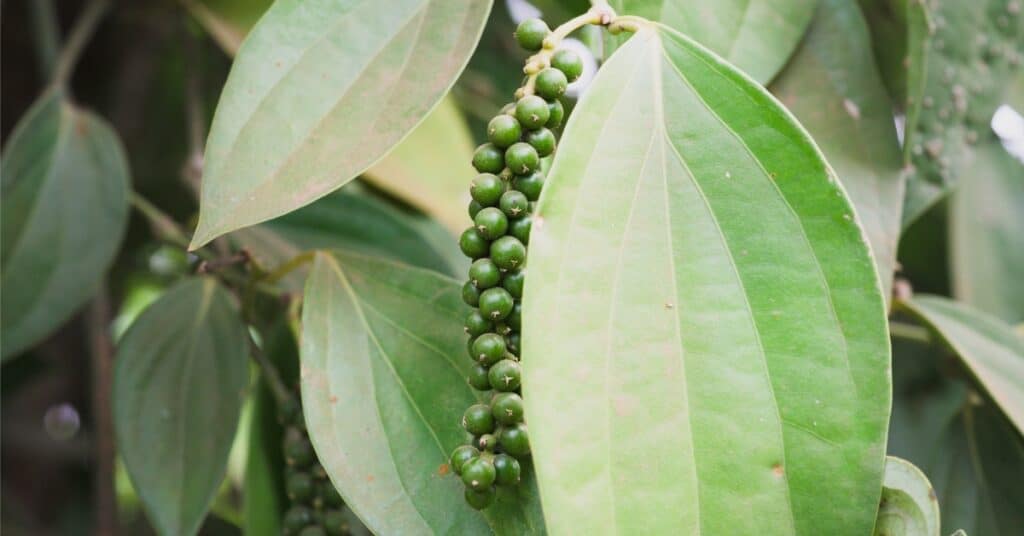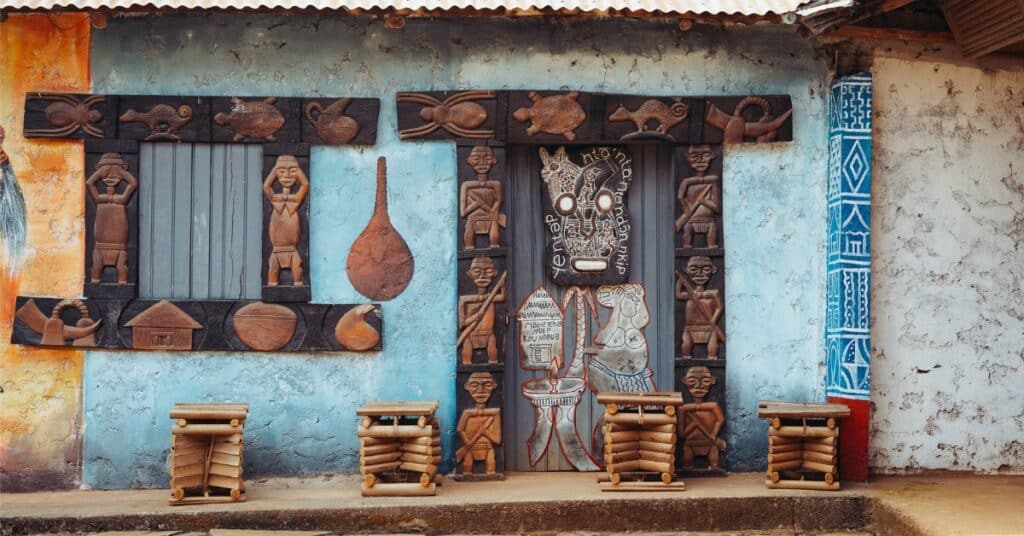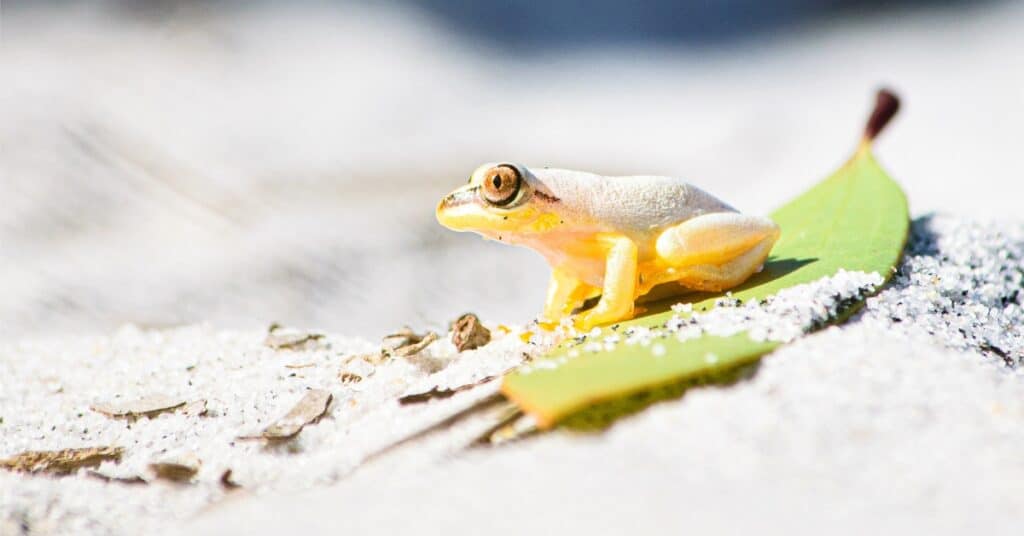D03 » Visiting Foumban and the Sultan’s palace
Today’s Quest: Venturing to the Sultan’s Majestic Palace in Foumban, Heart of the Bamum Kingdom. This evening’s rest will be in a different locality: the charming Villa Boutanga in Bangoulap, near the vibrant Bangangte.
Our day dawned with a spirited morning run along the rustic red dirt roads, a tapestry of both paved and unpaved paths; my father, Serge, and I returned to the guest house in the nick of time for breakfast, where my mother and my girlfriend awaited us with anticipation.
Following two serene nights in Tockem, we savored our final morning meal on the picturesque terrace, overlooking quaint huts below.
We then departed our lodgings, entrusted the keys back to the room steward, and embarked towards Foumban, the esteemed city of the Sultan of the Bamum, guardians of another illustrious grassfield culture.
En route, we bid farewell to the splendid square at the Bafou chiefdom, its gateway crowned with triangular capitals, iconic of the Bamileke nobles and chiefdoms.
Gliding past Bafoussam, courtesy of the modern roadway constructed for AFCON 2021 (Africa Cup of Nations), our journey took us northeast, through Foumbot and towards the historic Foumban.
As we ventured further, the landscape unfolded like a canvas of changing hues and textures. Departing from the lush embrace of the Ekom-Nkam tropical forest, we traversed through verdant wooded areas near Dschang and Bafoussam. Gradually, the terrain transformed into the sparse savannah around Foumban, where the sun began to paint the grass with strokes of gold.
This journey was a vivid illustration of Cameroon’s climatic diversity. In the south, the rich tapestry of equatorial forests thrived, while the north boasted the Sahel, marked by its warmth and arid whispers. Between these two extremes lay a spectrum of climates and landscapes, a testament to why Cameroon is often celebrated as “Africa in Miniature.”
But the journey through Cameroon was more than a shift in landscapes; it was a voyage through a kaleidoscope of cultures and beliefs. We witnessed the seamless transition from the predominantly Christian Bamileke region to the Muslim-majority Bamum lands.
Cameroon, a symphony of languages, beliefs, and traditions, danced in harmonious coexistence. Despite the underlying currents of tribalism and ethnic favoritism, Cameroon showcased a unique approach to religious diversity.
Here, beliefs were not wielded as tools of division, unlike some unfortunate instances in Europe. In this land where ancient beliefs in witchcraft still lingered, religions were not pawns in cultural clashes but threads in the rich tapestry of Cameroonian identity.
After journeying for two hours from Tockem, our voyage led us to the historic heart of Foumban, the esteemed capital of the Bamum kingdom, a realm steeped in history since its founding in the late 14th century.
Nestled near the bustling market at the city’s core stands the Sultan’s Palace, a monumental edifice and a testament to the Bamum kingdom’s grandeur. Here, we crossed paths with the delegation of the French ambassador, likely tracing a similar route through the region’s most iconic and culturally rich chiefdoms.
Constructed in 1917 with German architectural influences, the Sultan’s Palace commands respect with its formidable presence. This red brick and wood structure replaced the original grand wooden hut, tragically lost to fire a year earlier. Its stately courtyard, a silent guardian to the tombs of two legendary Bamum monarchs, spoke volumes of the kingdom’s revered past.
Upon arrival, knowledgeable guides stood ready at the entrance, eager to share the palace’s and the exhibition’s secrets. Ascending the staircase on the courtyard’s left wing, one embarks on a journey through time.
I advocate for embracing the wisdom of these professional guides. Their narratives bring to life the rich tapestry of Bamum culture, offering insights and delightful anecdotes about the lineage of chiefs who have shaped the kingdom’s destiny. Each story, each detail, enhances the understanding of this magnificent cultural beacon.
Upon arriving at the Sultan’s chiefdom, the first marvel that captures the eye is the newly inaugurated museum, a modern shrine to the Sultanate and the rich tapestry of Bamum culture.
Architecturally, the museum is a reflection of Bamum heritage, ingeniously embodying the three principal Bamum symbols: the spider, symbolizing patience and meticulous craftsmanship; the double bell, echoing unity and patriotic fervor; and the two-headed serpent, representing formidable strength and triumph on dual fronts.
However, within the context of Bamum history, this emblem celebrates the 18th-century victory of King Mbuembue, the eleventh monarch, who skillfully vanquished warriors Pou and Mgbètnka attacking from opposite directions.
While I reserve a more elaborate exploration of the museum’s exhibits and the deeper aspects of Bamum culture for a forthcoming narrative, this visit was but a window into their profound and storied heritage.
Concluding our museum visit, we embraced the opportunity to indulge in Ndjapche, a culinary masterpiece of the Bamum, blending corn and cassava flour with an array of vegetables, smoked fish, and meat, a true testament to the region’s rich gastronomic legacy.
Prior to our meal, while the cook artfully prepared our feast, we seized the chance to explore the nearby town’s forge.
This forge is renowned for its mastery in bronze molding, a craft deeply ingrained in the local artisanship, offering yet another layer of cultural immersion in our journey through this land of history and tradition.
At the heart of Foumban, the ancient art of bronze crafting is practiced with a reverence that transcends mere metalwork. This process, an alchemical blend of science and tradition, is a testament to the city’s rich cultural heritage. In Foumban, bronze isn’t just an alloy of copper with other metals like aluminum or tin; it is a canvas for expression, a medium through which stories of the past are told and preserved.
The journey of creating a bronze artifact in Foumban is steeped in a meticulous, almost ceremonial process. It commences with the crafting of a wax model. This model, intricate in its details, captures the essence of the artist’s vision. The wax sculpture, a fragile embodiment of the idea, is then carefully encased in a mold. This is where the transformation begins.
In the sweltering heat of the forge, the wax is melted away, leaving behind a hollow imprint within the mold, a void waiting to be filled with molten bronze. This is a moment of transmutation, where fire and metal converge to give birth to something timeless.
As the bronze is poured into the mold, it adopts the shape of the lost wax model. The glowing, molten metal slowly cools, solidifying into a form that marries the artist’s vision with the enduring strength of the alloy.
The blacksmiths, guardians of this ancient craft, then undertake the final, transformative step: applying a patina to the cooled bronze. This is not merely a finishing touch; it\’s a process that breathes life into the metal.
The patina stimulates oxidation, a reaction that imparts the distinctive blue hue to the bronze. This final act is a delicate balance of chemistry and artistry, resulting in a piece that is as visually striking as it is culturally significant.
Our forty minutes at the forge were a journey into the heart of Bamum craftsmanship. Each step, from the initial sculpting of wax to the final application of the patina, was a display of skill, passion, and a deep connection to cultural heritage.
Leaving the forge, we carried with us a newfound appreciation for the artistry and tradition that the bronze works of Foumban embody. Our timely return allowed us to savor the delectable “Ndjapche”, a dish that, much like the bronze art, is a blend of ingredients, each contributing to a greater whole.
This culinary experience was not merely a meal but a continuation of our cultural immersion, a fitting way to gather strength for the journey ahead to our restful abode for the night: The Villa Boutanga at the Jean-Felicien Gacha Foundation. This next destination promised to be another chapter in our exploration of Cameroon’s rich culture and tradition.
Upon journeying along the serene and nearly flawless road from Foumbot to Bangangte, our adventure led us to the tranquil haven of Villa Boutanga, our sanctuary for the night.
Nestled within this serene landscape is the Jean-Félicien Gacha Foundation, a beacon of hope and progress. This noble Non-Government Organization is dedicated to igniting passions, nurturing talents, and disseminating knowledge across diverse fields, encompassing education, arts and culture, health, social action, environment, agriculture, and tourism.
Villa Boutanga is renowned not just for its philanthropic endeavors but also for its cultural preservation. The site is a living museum, showcasing meticulously reproduced traditional huts from both the western and far northern regions of Cameroon. It is a place where architectural heritage from diverse corners of Cameroon coexists in harmonious unity.
During our stay, we explored the varied architectural wonders of the Musgum, Bororo, and Bamileke huts, each telling its own story of the people and their way of life.
The opportunity to capture the beauty of these structures with my drone as the sun dipped below the horizon was a moment of sheer magic, adding a visual narrative to our journey.
After a heartwarming and satisfying meal, we retired early in anticipation of the following day’s adventure, a trek to the enchanting twin lakes of Mt Manengouba. These lakes, nestled in the embrace of nature, are among my most cherished hiking destinations in Cameroon, offering a glimpse into a world untouched by time.
I invite you to immerse yourself in the tale of these mystical lakes through my previous writings, as they set the stage for the final leg of our journey through the western highlands of Cameroon. As the night deepens, I bid you goodnight, conserving my energy for the trek that awaits at dawn, a journey through the natural splendor and cultural richness of this magnificent land.



